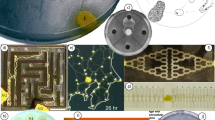Summary
Polybia sericea (Hymenoptera: Vespidae) prey foraging was studied by following individual foragers as they hunted in the field, by observing how wasps handled prey once they had captured it, and by observing wasps as they returned to the nest with prey. Wasps were most likely to forage for prey between 0700 and 1300 hours and between 1600 and 1700 hours. The prey foraging sequence consisted of the behaviours high flight, search, touch, land, groom, walk, bite and malaxate. Captured small prey were malaxated and carried to the nest. Wasps removed the gut from large prey and dragged the meat up a twig or grass stem. A load of the meat was then bitten off and malaxated; the remainder was cached while the wasp made an orientation flight and returned to the nest. The forager returned within minutes for the remainder of the prey. Experiments demonstrated that caching the prey remains above the ground rather than close to the ground, where the prey are generally captured, reduces the chance that the prey will be found and expropriated by ants.
Similar content being viewed by others
References
Duncan, C., 1939. A contribution to the biology of North American vespine wasps.Stanford Univ. Publ. Biol. Sci. 8:1–272.
Evans, H. E. and M. J. West Eberhard, 1970.The Wasps. University of Michigan Press, Ann Arbor, 265 pp.
Grinfel'd, E. K., 1977. The feeding of the social waspPolistes gallicus (Hymenoptera, Vespidae).Entomol. Rev. 56:24–29.
Heinrich, B., 1984. Strategies of thermoregulation and foraging in 2 vespid waspsDolichovespula maculata andVespula vulgaris.J. Comp. Physiol. B. Biochem. Syst. Environ. Physiol. 154:175–180.
Hirose, Y. and M. Takagi, 1980. Attraction of two species ofPolistes, to prey wounded by them.Appl. Entomol. Zool. 15:108–110.
Iwata, K., 1976.Evolution of Instinct. Comparative Ethology of Hymenoptera. Amerind Publishing Co., New Delhi, 535 pp.
Jeanne, R. L., 1972. Social biology of the Neotropical waspMischocyttarus drewseni.Bull. Mus. Comp. Zool. 144:63–150.
Jeanne, R. L., 1979. A latitudinal gradient in rates of ant predation.Ecology 60:1211–1224.
Prance, G. T., 1979. Notes on the vegetation of Amazonia III. The terminology of Amazonian forest types subject to inundation.Brittonia 31:26–38.
Rabb, R. L. and F. R. Lawson, 1957. Some factors influencing the predation ofPolistes wasps on the tobacco hornworm.J. Econ. Entomol. 50:778–784.
Raveret, M. A., 1981.Prey Foraging Behavior of the Tropical Social Wasp Polybia sericea (Hymenoptera: Vespidae). Masters thesis, University of Wisconsin, Madison, 89 pp.
Raveret Richter, M. A. and R. L. Jeanne, 1985. Predatory behavior ofPolybia sericea (Olivier), a tropical social wasp (Hymenoptera: Vespidae).Behav. Ecol. Sociobiol. 16:165–170.
Siegel, S., 1956.Nonparametric Statistics for the Behavioral Sciences. McGraw Hill, New York, 312pp.
Sokal, R. R. and F. J. Rohlf, 1969.Biometry. W.H. Freeman and Co., San Francisco, 776pp.
Steiner, A. L., 1974. Unusual caterpillar prey records and hunting behavior for aPodalonia digger waspPodalonia valida (Hymenoptera: Sphecidae).Pan-Pac. Entomol. 50:73–77.
Suzuki, T., 1978. Area, efficiency and time of foraging inPolistes chinensis antennalis Pérez (Hymenoptera: Vespidae).Jpn. J. Ecol. 28:179–189.
Takagi, M., Y. Hirose and M. Yamasaki, 1980. Prey location learning inPolistes jadwigae (Hymenoptera: Vespidae), field experiments on orientation.Kontyû 48:53–58.
Author information
Authors and Affiliations
Rights and permissions
About this article
Cite this article
Raveret Richter, M., Jeanne, R.L. Hunting behaviour, prey capture and ant avoidance in the tropical social waspPolybia sevicea (Hymenoptera: Vespidae). Ins. Soc 38, 139–147 (1991). https://doi.org/10.1007/BF01240964
Received:
Accepted:
Issue Date:
DOI: https://doi.org/10.1007/BF01240964




